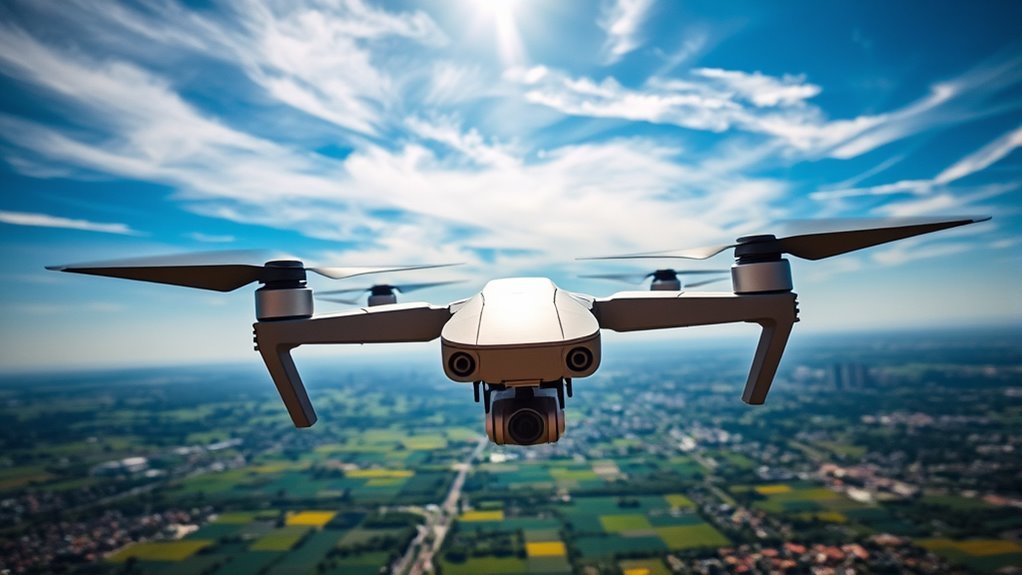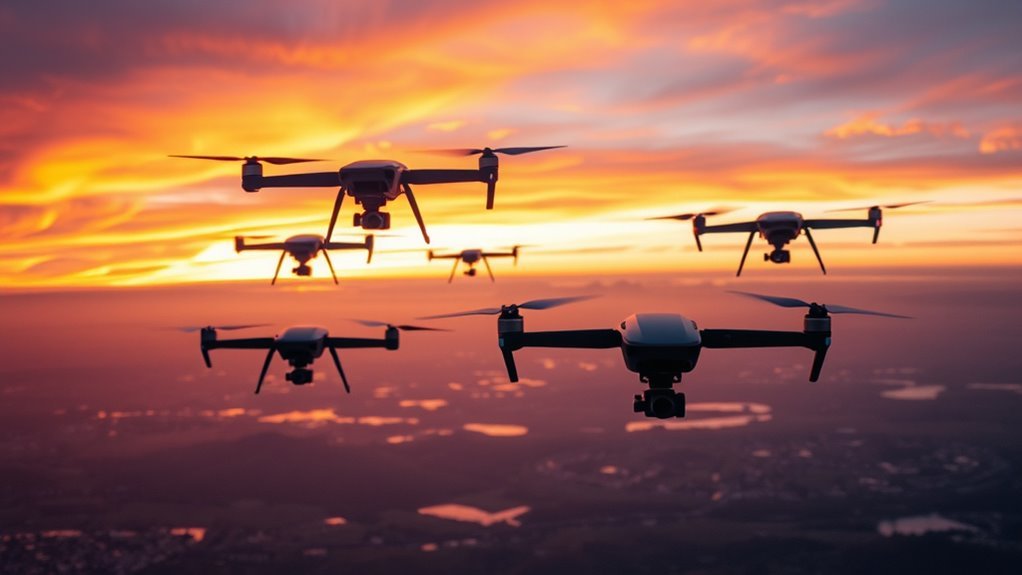Drones can typically fly up to 400 feet under FAA regulations, but various factors influence their actual altitude capabilities. Payload weight, battery performance, and environmental conditions directly affect flight height. Commercial drones usually operate between 100 to 400 feet, while military drones can exceed those limits considerably. Technological advancements are also pushing altitude potential higher. Understanding these aspects can optimize your drone’s performance. Explore further to gain insights into the factors that can elevate your drone flight experience.
Factors Influencing Drone Altitude

When considering how high drones can fly, several factors come into play that can greatly influence their operational altitude. Drone performance is primarily affected by weight, battery life, and environmental conditions. Heavier payloads reduce lift capacity, limiting altitudes. Battery efficiency directly impacts flight duration and altitude maintenance; a drained battery can greatly reduce performance. Additionally, environmental factors, such as wind speed and temperature, can affect lift and maneuverability. Understanding federal aviation regulations is crucial when determining safe operational altitudes. Altitude optimization involves balancing these elements to achieve maximum height without compromising stability or safety. By understanding these influences, you can better navigate the intricacies of drone operation and make informed decisions about your flight objectives, ensuring you harness the full potential of your drone while enjoying the freedom of the skies. Professional drones often feature advanced communication systems, which enhance their ability to maintain stable connections even at higher altitudes.
Regulatory Restrictions on Drone Flight Heights

When operating drones, you must consider both Federal Aviation Administration (FAA) guidelines and local airspace regulations. These regulations dictate maximum flight altitudes and specific limitations based on airspace classifications. Understanding these restrictions is essential for compliant and safe drone operation.
Federal Aviation Administration Guidelines
Although drone technology has advanced considerably, federal regulations still impose strict guidelines on flight heights to guarantee safety and airspace integrity. The FAA regulations dictate specific altitude restrictions for drone operations, which can feel limiting for enthusiasts seeking freedom in the skies.
| Altitude Category | Maximum Height (Feet) |
|---|---|
| Recreational Use | 400 |
| Commercial Use | 400 |
| Beyond Visual Line of Sight | 400 |
| Controlled Airspace | Varies by Airspace |
Understanding these limitations is essential for compliance. While these altitude restrictions may seem confining, they help maintain order in increasingly crowded airspace. Maneuvering through these regulations effectively allows you to enjoy your drone experience while ensuring safety for all aerial users.
Local Airspace Regulations
While federal guidelines provide a framework for drone flight heights, local airspace regulations can impose additional restrictions that vary considerably by location. These regulations often dictate altitude restrictions that you must adhere to, greatly influencing your drone’s operational capabilities. For instance, some municipalities may limit drone flights to lower altitudes to protect privacy or guarantee safety near populated areas. It’s vital to research specific local airspace rules, as failure to comply can result in fines or confiscation of your equipment. Additionally, no-fly zones, often established around airports or sensitive sites, can further constrain your flight options. Ultimately, understanding these local regulations is fundamental for maximizing your freedom while operating drones within legal boundaries.
Types of Drones and Their Altitude Capabilities

When considering the altitude capabilities of different drone types, it’s crucial to understand the distinctions between recreational, commercial, and military drones. Recreational drones typically have lower altitude limits, while commercial models can reach higher ceilings due to regulatory allowances. In contrast, military drones are designed for extensive operational ranges, often exceeding typical civilian altitudes considerably. Additionally, registration requirements vary significantly depending on the drone’s intended use and capabilities, influencing where and how high they can operate. For instance, operators must adhere to federal regulations that govern flight operations to ensure safe and legal drone usage.
Recreational Drone Altitudes
How high can recreational drones actually fly? For most drone enthusiasts, altitude capabilities vary considerably based on the model. Typically, consumer drones are regulated to fly at a maximum altitude of 400 feet above ground level. However, some high-performance models have achieved altitude records exceeding 10,000 feet under controlled conditions. These records often push the limits of battery life and signal strength. While the thrill of soaring higher is enticing, it’s crucial to adhere to local regulations to guarantee safety. Understanding your drone’s specifications will allow you to maximize your flying experience while respecting airspace restrictions. Ultimately, the freedom of flight lies in balancing ambition with responsibility.
Commercial Drone Limits
As you explore the world of commercial drones, it’s essential to recognize that their altitude capabilities vary considerably based on their intended applications and design features. Understanding these differences can help you choose the right drone for your needs. Here are three primary types of commercial drone applications:
- Surveying and Mapping: Often operate between 100 to 400 feet for detailed data collection.
- Drone Delivery Systems: Typically fly lower, around 100 to 200 feet, to navigate urban environments safely.
- Agricultural Drones: Can reach altitudes of up to 400 feet for effective crop monitoring.
Each type serves its purpose, and knowing these limits guarantees you maximize efficiency while adhering to regulations.
Military Drone Capabilities
Military drones, also known as unmanned aerial vehicles (UAVs), exhibit a diverse range of altitude capabilities tailored to their specific operational roles. For instance, tactical drones like the RQ-11 Raven typically fly at lower altitudes of around 1,500 feet for precise drone reconnaissance and military applications. In contrast, medium-altitude long-endurance (MALE) drones, such as the MQ-1 Predator, can reach up to 25,000 feet, enabling broader surveillance and strike capabilities. High-altitude long-endurance (HALE) drones, like the Global Hawk, can soar above 60,000 feet, providing extensive reconnaissance over vast areas. Each drone type serves distinct functions, optimizing altitude to enhance mission effectiveness while maintaining operational security, thereby ensuring tactical advantages in complex environments.
Technological Advancements Impacting Flight Limits
While advancements in materials science and propulsion technology continue to evolve, they markedly enhance the altitude capabilities of drones. You’ll find that these innovations are essential for maximizing flight performance and ensuring autonomous navigation. Key factors include:
- Advanced composite materials that reduce weight while maintaining strength.
- High-efficiency propulsion systems optimized for altitude performance.
- Intelligent flight control algorithms that facilitate altitude optimization, similar to the AI integration found in imaging systems.
These elements work together to push the boundaries of drone flight. As you explore these advancements, you’ll see how they contribute to greater operational freedom and potential applications. Ultimately, the intersection of technology and design will likely redefine the heights drones can achieve, making your aspirations for aerial exploration more attainable than ever. Furthermore, the integration of advanced AI and autonomy in drones is crucial for enhancing their operational capabilities at increased altitudes.
Future Trends in Drone Altitude Potential
Although the current capabilities of drones are impressive, future trends indicate a significant evolution in altitude potential driven by emerging technologies and regulatory changes. Altitude innovations, such as enhanced propulsion systems and lightweight materials, will empower drones to reach unprecedented heights. As battery technology advances, you’ll see longer flight durations and the ability to operate at higher altitudes without compromising performance. In addition, future applications, including urban air mobility and expansive agricultural monitoring, necessitate these increased altitudes. Notably, drones like the DJI Mavic 3 Pro are already showcasing the potential for longer flight times, which can enhance altitude capabilities. Regulatory frameworks are evolving, too, potentially lifting altitude restrictions for certain drone categories. As these developments unfold, your access to the skies will expand, offering greater freedom and opportunities for innovative uses of drone technology. Furthermore, advancements in drone navigation systems will improve altitude control and stability, allowing operators to explore new flight possibilities.
Safety Considerations for High-Flying Drones
As drones push higher into the skies, safety considerations become paramount. When you’re flying at increased altitudes, understanding drone safety and potential altitude risks is essential. Here are some key factors to keep in mind:
- Airspace Regulations: Know the designated airspace and any restrictions that apply to your drone operations. Additionally, adhering to frequency allocation helps prevent signal interference that could affect control.
- Weather Conditions: Monitor real-time weather data to avoid turbulence and other hazardous conditions that can affect flight stability.
- Technical Reliability: Regularly check your drone’s systems and software to guarantee peak performance at higher altitudes. Additionally, be aware of line of sight requirements to ensure compliance with safety regulations while operating at great heights.
Frequently Asked Questions
Can Drones Fly Higher Than Commercial Airliners?
Drones’ capabilities often exceed commercial airliners’ altitudes, but aviation regulations typically restrict their operational height. You should consider these limitations when evaluating a drone’s potential flight ceiling compared to traditional aircraft.
What Altitude Is Considered Safe for Drone Operation?
When considering drone altitude regulations, it’s essential to adhere to safe flying practices. Generally, maintaining an altitude below 400 feet guarantees compliance and minimizes risks, allowing you to enjoy the freedom of flying responsibly.
How Do Weather Conditions Affect Drone Altitude?
Weather conditions greatly impact drone altitude. Wind resistance can destabilize flights, while temperature effects may alter battery performance and lift. You’ll need to monitor these factors to guarantee safe and efficient drone operation in varying conditions.
Are There Altitude Restrictions for Specific Drone Models?
Yes, there are altitude restrictions based on drone model specifications. Compliance with altitude regulations guarantees safety and avoids airspace conflicts. Knowing your drone’s limits helps you operate freely while adhering to legal requirements.
What Happens if a Drone Exceeds Its Maximum Altitude?
If your drone exceeds its maximum altitude, it may experience degraded performance due to altitude sensors failing. This could lead to loss of control, decreased battery efficiency, and potential safety hazards during flight operations.

